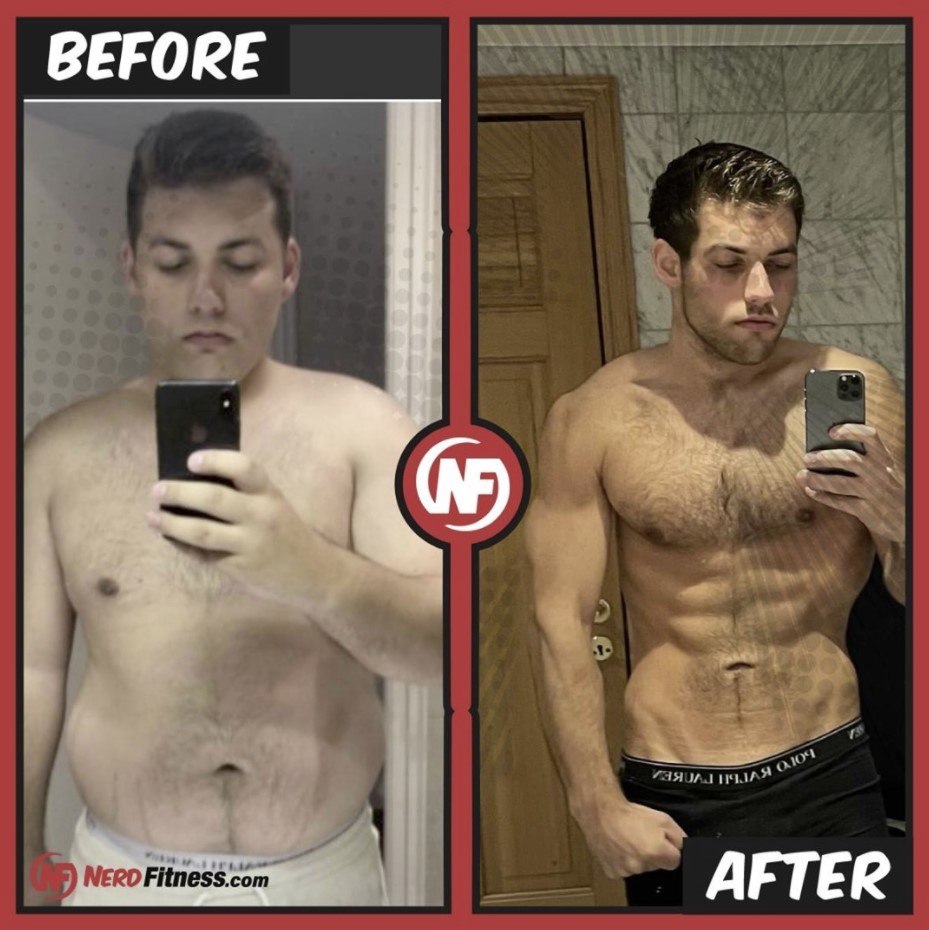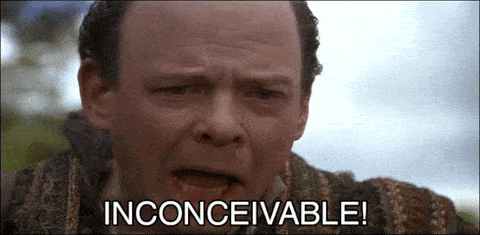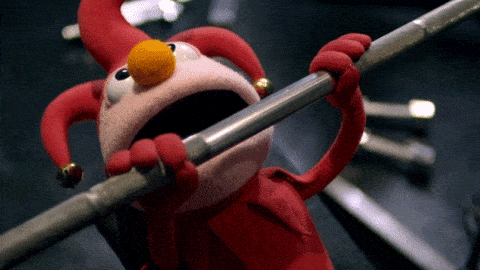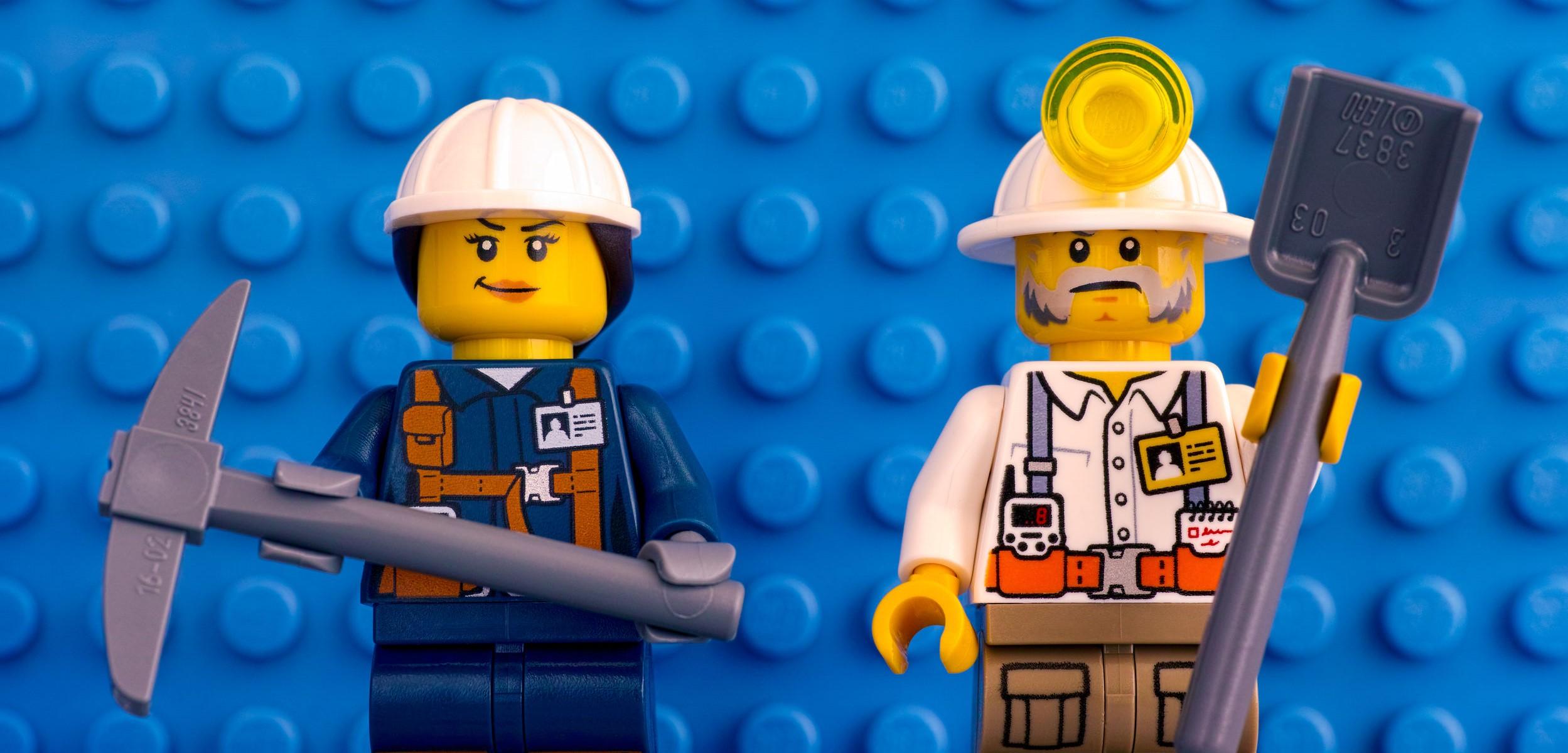
There’s an argument in the fitness world that you can either lose fat OR gain muscle.
They just can’t be done simultaneously.
To this, I say, “Hogwash!”
We have tons of success stories from our online coaching clients who have been able to do both simultaneously:
And that’s what we’ll cover in today’s guide!
We’ll do so by discussing:
- What is body recomposition?
- Losing fat and gaining muscle at the same time (The Controversy)
- How to lose fat
- How to gain muscle
- How to lose fat WHILE gaining muscle (The Science)
- Tips to lose body fat while gaining muscle (Putting It All Together)
- What should I eat to gain muscle and lose fat? (A Healthy Plate)
- How to tell if it’s all working (Continuing to lose fat while gaining muscle)
- Is body recomposition the right strategy for me?
- Can I do body recomposition forever?
Plus, I have tons of sweet LEGO photos and silly gifs along the way, which is always a good time.
What’s Body Recomposition?
Gaining muscle and losing fat simultaneously is called “body recomposition.”
And yes! The process is indeed possible, as long as you follow the right plan.
…but you don’t have to take my word for it.
Just ask our friend Aksel here (who achieved an impressive body recomposition with the help of his Nerd Fitness Coach):

Read more about his incredible story!
However, as I mentioned in the intro, you’ll often hear that losing fat while gaining muscle is impossible. The argument goes that you should just focus on one or the other, because doing both at once is destined to fail.
Let’s explore this claim.
Losing Fat and Gaining Muscle at the Same Time (The Controversy)
To understand why losing fat while gaining muscle can be problematic, we need to explore both processes.
Let’s consider the following points:
-
To lose fat, your body needs to be in a caloric deficit. This deficit forces your body to use pre-existing fat stores for fuel.
-
To gain muscle, your body needs to be in a caloric surplus. This surplus provides the energy your body requires to repair and build bigger muscles.
Given this, losing fat (caloric deficit) at the same time one is gaining muscle (caloric surplus) seems impossible.
However, if we go a few steps deeper into the science, it IS possible!

To appreciate the nuance here, let’s get into some specifics on losing fat and gaining muscle separately, and then we’ll combine them.
HOW DO YOU LOSE FAT?

There is a simple answer and a slightly less simple answer when it comes to losing body fat.
The simple answer: “consume fewer calories than you expend or burn.”[1]
Eight words, and one or two of those could probably be thrown out.
When your body needs more calories than the amount you are eating, you are in a “caloric deficit.” Your body doesn’t have the calories it needs as fuel, so it’ll start breaking down parts of itself for its energy requirements.
(If you’re curious, you can calculate your daily caloric needs here).
The hope is that your body will mostly pull from fat stores, though depending on how you are training it will also break down muscle too.[2]
Said again: when you are eating a caloric deficit, your body will pull from both its fat stores AND existing muscle for energy.

Troubling indeed.
From a physique and health standpoint, obviously we’d prefer that your body doesn’t break down muscle when in a caloric deficit, and instead really focuses on using fat stores instead.[3]
I make this point for a reason: your goal in fitness shouldn’t only be “weight loss,” despite the common vernacular used.
Who cares what the scale says, right?

The goal instead is to reduce body fat while also keeping the muscle you have (or even building more muscle).
That leads to a better physique and a healthier body.
This is why there is a big market for devices that supposedly assess your body fat percentage.[16]
By reducing the total fat on your body, OR increasing muscle mass, you’ll end up with a lower body fat percentage (it’s just a simple ratio of fat to everything else).
And lower body fat percentages are where “toned arms” and “6-pack abs” hang out.

We’ll discuss tips on keeping and growing your muscle while in a calorie deficit later in this guide. For now, remember you need fewer calories “in” compared to calories “out” for weight loss to occur, from either fat stores or muscle.
You may be asking, “Steve, what’s easier to do? Burn more calories or consume less?”
Good question.
Numbers will help tell the story: though this is a gross oversimplification – let’s use the ‘widely accepted’ starting point of “3,500 calories equals roughly one pound of fat.”[4]
If you want to lose one pound – or half a kilogram – of body fat in a week (a worthy, sustainable goal for some), you need to create a caloric deficit of 500 calories per day.
Your options to create this caloric deficit include:
- Consuming 500 fewer calories
- Burning 500 more calories
- A combination of the two
Which is easier?
Here are both halves of that equation. 500 calories equals:
- The number of calories found in a Big Gulp of Mountain Dew.
- An estimate of the calories required to run five miles.

Yep.
When it comes to maintaining a caloric deficit, your first line of defense is diet.
It’s significantly more effective and time-efficient to consume 500 fewer calories than it is to burn 500 additional calories.
As Time magazine controversially pointed out – with tons of cited studies – “exercise alone won’t make you thin.” It’s too easy to add more calories in, and requires too much work to effectively influence “calories out.”
On top of that, exercise naturally increases appetite, which can lead to an increase in calorie consumption. [17]
We dig into all of this in our guide to The CICO Diet.
This brings us to our slightly less simple answer on getting in shape:
To lose body fat, you need to watch what you eat, and do so in a sustainable way.
Here at Nerd Fitness, we are firm believers that 80-90% of the fat-loss equation comes down to diet.
Here’s another idea we focus on: EAT MOSTLY UNPROCESSED FOOD.[5]

Meat, fish, eggs, vegetables, fruits, nuts are all great examples.
These foods are very nutrient-dense and often low in calories compared to their processed counterparts. Which means you get filled up without overeating.
Win-win-win.
Have you ever seen the difference between 200 calories of broccoli and 200 calories of a bagel? WiseGEEK does a great job of displaying this, so we’ll borrow a couple of their photos.
200 calories of broccoli:

200 calories of a bagel:

That’s why whole food sources are a great tool in creating a sustainable caloric deficit.
Most people can eat an entire bagel, no problem. Plates of broccoli, with all of the fiber, are much tougher to overeat.
We lay it all out in our Beginner’s Guide to Healthy Eating. It’ll provide tips on how to gradually build healthy eating habits, including proper portion sizes, tips on batch cooking, and a cameo from Winnie the Pooh.

With all of this, we advise you to take it slow and focus on consistency first, so your new habits become permanent.
Something you can do for the rest of your life.
It’s a strategy we work closely with our coaching clients on: small nutritional adjustments they feel comfortable making. It’s how some of them have been able to lose 50-100 pounds!
Let me explain again: what you eat will be 80%-90% of the equation for losing body fat.
The other 10-20%? Exercise.
Of course it’s exercise.
That’s a pretty good segue into…
HOW DO YOU GAIN MUSCLE?

If you want to build muscle, you’ll have to lift heavy things and ensure that your body has enough calories and protein to adapt by building more muscle.
In our Beginner’s Guide to Building Muscle and Strength, I summarize it as follows:
- Lift heavy things
- Eat a diet based on your goals
- Rest so your body can recover
Let’s chat about each one quickly.
#1) Lift heavy things
I will always be on Team Strength Training. If you’re looking to build muscle, you’re gonna need to lift heavy things.

When you lift an object (or your own bodyweight) enough times, your muscles reach the point of failure. This causes your muscles to tear and breakdown.
When your muscle rebuilds itself following the workout, it’ll be bigger and stronger than before. Then you do it again.
And again.
And again.
As long as you are eating enough to rebuild your muscle, you’ll get stronger!
#2) Eat a diet based on your goals
Because your muscle needs to be rebuilt after exercise, the calories are gonna need to come from somewhere. I’ll talk a lot about proper diet in the next section (with a Harry Potter analogy), so I won’t spend too much time on it here.
Just know that eating the right quantity of foods will be a big part of gaining muscle.
#3) Rest
Your body rebuilds itself while you sleep, so make sure you get plenty of rest each night. I’m talking 7-8+ hours. This will help ensure your body has the time it needs to grow stronger.
If you’re strength training and only getting 6 hours of sleep a night or less, you’re really doing yourself a disservice. Go to bed!

That’s the short gist of how to build strength: challenge your muscles, eat well, and get some rest.
Let’s narrow in on our second point, “Eat a diet based on your goals.” It’ll become very important when balancing both losing body fat and gaining muscle.
To do that properly, grab your owl, and let’s chat about Hogwarts.
How to Lose Fat WHILE Gaining Muscle (The Science)

To answer the question of losing body fat and gaining muscle at the same time, I’d like to introduce an analogy from the world of Harry Potter.
Recall the “Sorting Hat:” The Sorting Hat’s job was to determine which of the four houses new students will call their home.

It’s almost like a traffic director: “Harry, you will go to Gryffindor! Draco, you will go to Slytherin!”
Your body operates on a VERY similar operation: every day it receives new calories (when you eat) and then decides what to do with them!
For example:
You eat a chicken parm sub with fries and a 20-ounce soda. Your body then has to know where to route all those calories.
To keep things simple, it has three choices. It’ll sort those calories into one of three houses:[6]
A. Burn for Fuel
B. Rebuild Muscle
C. Store as Fat
Right now, when you eat food, your body sorts most of those calories into “Burn for Fuel.”
There’s a number of calories your body needs each day to stay alive: to keep your liver functioning, your heart pumping, your brain operating, to regulate your body temperature, and so on – it burns a good chunk of calories just keeping the lights on.

This is your “Basal Metabolic Rate” which you can calculate for yourself in our TDEE calculator.
There’s also “B. Rebuild as Muscle” and “C. Store as Fat,” which I devoted entire sections to above.
This is where the problems arise: When you overeat calories and your body doesn’t need any more to fuel itself, it takes those extra calories and stores them as fat.
However, our goal is the OPPOSITE of this.
We want to keep the muscle we have (or grow it) while getting rid of the fat!
So let’s imagine a scenario where we pull all this together by strength training heavy AND reducing our caloric intake:
- You strength train regularly, and your muscles break down and need to be rebuilt.
- You don’t consume enough calories to both rebuild muscle and fuel itself. There’s not enough to go into the “Burn for Fuel” and “Rebuild Muscle” houses.
Does your body just shut down?
NOPE!

Your body has been preparing for this, by storing any excess calories over the years in the “Store as Fat” house.
This means your body can pull from “Store as Fat” to make sure all the work still gets done, including your daily functions as a human and rebuilding the muscle you tore apart.
Said another way:
If you have fat stores (and we all do), you do not need to be in a “caloric surplus” to rebuild muscle. The calories stored in your fat cells act as this required energy.
There is also evidence that muscle can even be grown while in a caloric deficit.[7]
Meaning bigger muscles with a lower belt size.[8]

However, if you want to skip all the experimentation and trial and error, you can have a Nerd Fitness Coach do all the heavy lifting for you (not really, you’ll still need to work out).
TIPS TO LOSE BODY FAT WHILE GAINING MUSCLE (Putting It All Together)

Let’s bring this all together and create some actionable steps to losing body fat and building muscle at the same time.
#1) Sustain a caloric deficit
You need your body to burn more calories than you consume.
You can only lose fat if you’re in a calorie deficit.
Remember the Sorting Hat analogy:
If you’re eating too much, your excess calories are being sent to the “Store as Fat” house.
We want to pull from this house instead. So eat less than you burn consistently. [18]
To help here, I have 3 resources for you:
- Beginner’s Guide to Healthy Eating. If you want tips and tricks to create sustainable nutrition habits, this guide will help get you there.
- “Determining the Perfect Diet for You.” I talk about the benefits of creating a Mental Model on nutrition like Intermittent Fasting, Paleo or Keto (or Paleolithic Ketogenic) to help navigate all the food choices you need to make.
- Count calories: This means learning your total daily energy expenditure, and tracking your other calories through an app (and/or weighing your food).
You don’t have to follow some predetermined blueprint like “low-carb.” You can create your own diet (which is what I do). Learn all about it right here.
#2) Strength train
If you could sell a pill that could be prescribed to every single person on Earth to make them healthier, it would look something like a strength training routine in a bottle.

It is one of the best things you can do for your body.[9]
And really, if you want to build muscle, you’re gonna need to lift something! Either weights or your own bodyweight.
You need to challenge your muscles in order for them to get stronger. Now, as we discuss in our article on the correct number of reps and sets, there are multiple ways to do so.
To build muscle:
Lift lighter weights for lots of reps.
Lift really heavy with fewer reps.
In either case, it needs to be challenging enough that you are getting close to ‘failure’ (i.e. inability to perform the exercise with proper technique anymore.)
The good news? Either method can be effective for building muscle.[19]
The important thing: pick a strategy and get started.

Here are 3 paths forward:
- Start with a Beginner Bodyweight Workout.
- Follow one of our 5 Beginner Strength Training Routines.
- Go through our 6-Level Gym Workout Progression.
To recap: if you train heavy and eat a caloric deficit, your body will pull from its fat stores to both fuel itself and potentially also build muscle. This is a double whammy of AWESOME.
#3) Prioritize protein
Outside of being in a caloric deficit and lifting weights (or yourself), eating enough protein is one of the key components of both losing body fat and building muscle.
Protein is the number one nutrient for creating new tissue.[10]

So when you cut out calories to create a caloric deficit, don’t cut them from protein sources.
Studies have shown that participants can gain muscle, even while in a caloric deficit, as long as they eat enough protein.[11]
It’s important enough that I’ll say it again:
If you don’t want your body cannibalizing its muscles while you are in a caloric deficit, you need to eat plenty of protein.[12]
How much protein?
As we point out in our Guide to Protein, roughly 0.7-1 grams of protein for every pound of your weight, with an upper limit of 250 grams.[13] Or two grams for every kilogram if you are on the metric system. This means:
- If you weigh 300 pounds (136 kg), eat 210-250g of protein.
- If you weigh 250 pounds (113 kg), eat 175-250g of protein.
- If you weigh 200 pounds (91 kg), eat 140-200g of protein.
- If you weigh 180 pounds (82 kg), eat 126-180g of protein.
The gist: don’t skip out on protein. It should be on your plate for every meal (we’ll show you exactly how much in the next section).
If these generalized recommendations stress you out, and you want to know exactly what to do, we can help!
I’ll remind you of Nerd Fitness Coaching, where we help clients lose body fat, gain muscle, and level up their lives. We provide tailored and specific recommendations based on your body and lifestyle, plus accountability and mindset changes to help ensure your new habits stick.
WHAT SHOULD I EAT TO LOSE FAT AND GAIN MUSCLE?

Remember, your eating strategy needs to include two points to lose fat while gaining muscle:
- Sustain a caloric deficit.
- Prioritize protein so you can build muscle even while in a deficit.
You may be thinking, “That’s all well and good Steve, but what’s that actually look like?”
It looks like this!

Taken from The Nerd’s Guide to Healthy Eating, which I really want you to read.
The plate is composed of the following:
- 1-2 servings of protein (¼ of plate)
- 2 servings of vegetables (½ of plate)
- 1 serving potatoes, rice, or pasta. (1/4th of plate)
- 1 serving of fat (size of your thumb)
- 1 zero-calorie or low-calorie beverage (water, diet soda, tea)
By sticking to our Healthy Plate strategy above, you’ll focus on nutrient-dense and filling foods, which will help you maintain a caloric deficit over time.
Let’s hone in on protein for a moment, because it’s the critical piece for “building muscle.”
Protein can come from any number of sources, including:
- Meat (steak, bison, pork).
- Poultry (chicken, turkey, duck).
- Eggs![14]
- Fish and shellfish (salmon, tuna, shrimp).
- Legumes (black beans, chickpeas).
Not a meat-eater? Read our massive plant-based guide!
A serving of protein is about the size and thickness of your palm.

*The 4 oz serving is for an uncooked piece of meat. Cooking reduces about 25% of the weight, bringing it down to about 3 oz.
If you’re curious, here’s how much protein is in a serving of food:
- 4 oz (113 g) serving of chicken has around 30 g of protein.
- 4 oz (113 g) serving of salmon has 23 g of protein
- 4 oz (113 g) of steak has 28 g of protein.
While all of the Healthy Plate above is important, I want you to pay extra attention to your protein intake since we are trying to build muscle.
If you’re having trouble making your protein intake goals, check out our Guide on Protein Supplements for some tips and tricks to up your intake, including some awesome smoothie recipes.
This is the exact strategy I followed to lose 22 pounds and get to single-digit body fat percentages WHILE building muscle:
- Lift super heavy.
- Eat LOTS of protein.
- Reduce carb and fat intake.
If you are NOT losing weight, it means you are still eating too many calories. Keep your protein intake high, and reduce your fat and carbohydrate intake.
I cover this in greater detail in our “Why Can’t I Lose Weight?” guide.
Eventually, you’ll reach a status where there just isn’t enough fat on you to help with “Rebuild Muscle.” At this stage, you can no longer stay with a caloric deficit. You’ll need to flip to a slight “caloric surplus” to build more muscle.
Which means you’ll have to eat more.

Which brings us to our next point – how do we know if our body recomposition strategy is working? And is this the best strategy for me?
HOW TO TELL IF IT’S ALL WORKING (Continuing to Lose Fat While Gaining Muscle)

If you’re trying to improve something, it’s important to track it. This also holds true of body composition.
Most people do this by jumping on the scale. This can be “okay,” but it’s only going to tell part of the story.
If you’re building muscle while losing fat, the scale might not go down. [15]
Despite weighing the same, you could potentially have an improved physique.

That’s why in addition to jumping on the scale, I would also encourage you to take progress photos.
Take front and side photos in your mirror, wearing underwear or a bathing suit. Each week, take new photos, and record the number on the scale under the same scenario. Two forms of tracking here allow us to get the full picture.
The scale sometimes lies!
If you eat for a caloric deficit, strength train, and prioritize protein, see what happens.
You may find yourself losing some fat and gaining muscle.
If not, track each category:
- Are you really in a caloric deficit? Track your calories to find out.
- Are you lifting enough? Perform resistance training consistently and track your workouts to determine whether or not you’re progressing via increased weight or repetitions.
- Are you prioritizing protein in your meals? Track your macronutrient breakdown each time you eat.
Data can help tell the story.

…I was thinking of detailed notes.
But an android would be helpful too.
Oftentimes if you’re not seeing desired results, notes and record-keeping can help point us in the direction to make adjustments.
Test your assumptions if things don’t appear to be on track. Here’s our Guide on Tracking Fitness Progress for you to learn more.
IS BODY RECOMPOSITION THE RIGHT STRATEGY FOR ME?
It all boils down to this. As we’ve seen with the data and with real-world examples from our clients, body recomposition is indeed possible. But is it the right strategy for you? Here are some recommendations to keep in mind.
Body recomposition is a great strategy for you if:
- You are starting your fitness journey. It allows you to focus on a sustainable calorie deficit, lifting weights, and feeling good. You’re likely to see steady progress for 12-18 months without much need for deviation!
- You feel burned out on dieting. By adding in more calories and going for a moderate body recomposition strategy, you can reduce diet fatigue while still making steady progress.
- You want to maintain the maximum amount of muscle while you lose fat. Enough said.
- You enjoy it!
- You prefer an approach you can sustain for longer periods. Versus more intense fat-loss phases that you may need to cycle off of every 8-12 weeks.
Body recomposition may not be the right choice for you if:
- You want to lose the maximum realistic amount of body fat per week. From experience, we’ve seen that a lot of people who THINK they want body recomposition actually just want to lose a lot of body fat. Which is totally cool! We recommend starting with a fat loss program and likely a slightly higher caloric deficit. You can always come back to body recomposition later on.
- You need quick wins to stay motivated. Body recomposition, by definition, is a slower strategy than focusing on fat loss or muscle building exclusively, as you’re essentially dividing your attention between two goals. If you want faster results in one direction, we recommend narrowing your focus.
- You are really close to your goal body fat %. The closer you get to your goal, the harder it will be to build muscle and lose weight at the same time.
Can I Body Recomp forever?
No, you cannot lose body fat while gaining muscle forever.
When you’re first starting, focusing on body composition is a great strategy and can give you a lot of progress.
But with consistent workout and nutrition habits over many months and years, you may notice that your changes and progress slowing down or plateauing.
At this point for many, going into a more distinct muscle/weight gain phase for several weeks, followed by a fat/weight loss phase for several weeks will produce results faster than doing both at the same time.
Does that mean it’s the best course of action for everyone?
Not necessarily!
- For some, they enjoy the relative simplicity of body recomposition tactics and it’s less to mentally think about. They still feel great, look much different than when they started, and are completely content with how everything is going.
- For others, switching from weight gain/weight loss phases might be stressful and triggering, especially if they have a checkered history with their nutrition. So while distinct phases of gains and losses may work best in theory, they might not be ideal for everyone.
Choose what’s best for you!
And if you’re looking for a pro to help you navigate through all these questions and situations, check out Nerd Fitness Online Coaching! The team spends all day talking about these sorts of things. That and Super Smash Bros.
Alright, I think that about does it for this guide.
Did I miss anything? Do you have any tips and tricks when it comes to shedding body fat and building muscle?
Share it with us!
-Steve,
PS: Make sure you read the rest of the articles in our “How to Lose Weight 101” Series!
- The Beginner’s Guide to Healthy Eating
- Why Can’t I Lose Weight?
- How Many Calories Should I Eat? (Our TDEE Calorie Calculator)
- What’s the Perfect Diet for Me?
All photo sources are right here: Venting Off, Ekaterina Minaeva © 123RF.com, czgur © 123RF.com, morethanl8ve © 123RF.com, Константин Колосов © 123RF.com, Maxim Maksutov © 123RF.com, Julianna Funk © 123RF.com, jump




